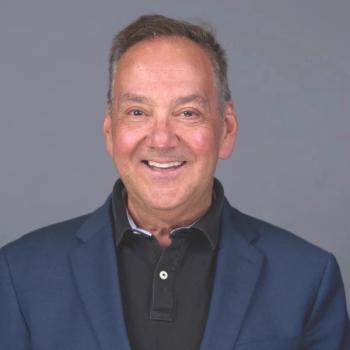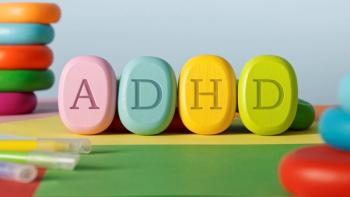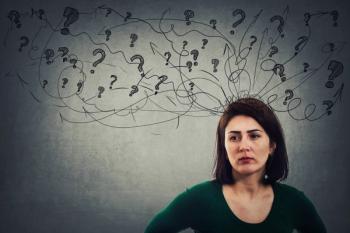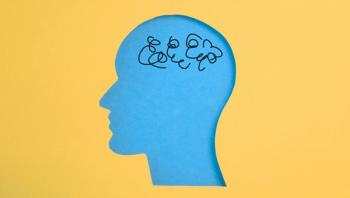
- Vol 39, Issue 10
Exploring Integrative Medicine and Nutrition for PTSD
"Among adults living in the United States, 38% to 40% use complementary and alternative medicine therapies, yet only 42% have told their primary physician that they do so."
SPECIAL REPORT: INTEGRATIVE MEDICINE
Evidence from a growing number of studies suggests that 38% to 40% of adults living in the United States use
Moreover, integrative medicine (IM) appeals to groups like veterans who traditionally avoid or experience dissatisfaction with conventional treatment and are prone to posttraumatic stress disorder (
Integrative medicine and
Digestion, Nutrition, and PTSD
Stress and trauma affect all aspects of physical function: blood glucose levels, brain metabolism, energy, and altered brain structures where neurons misfire or fail to communicate. When stress dysregulates digestion, it leads to a cascade of events affecting mood, cognition, sleep, and immune function. Parasympathetic activity governs digestion, which explains why in PTSD and complex trauma, there is at least 1 associated digestive problem.
In sympathetic arousal, the head hurts, the stomach aches, and the intestines are too active or immobilized by fear. Irritable bowel syndrome (IBS) often co-occurs with traumatic stress, and chronic gut distress can lead to PTSD.6 Similarly, there is a causal chain that links childhood abuse, dissociation, and somatization with IBS.7
These often-explicable somatic symptoms represent a complex neuroimmunomodulatory communication system between the gut and the brain. Gut bacteria regulate the hypothalamic-pituitary-adrenal (HPA) axis8 and γ-aminobutyric acid (GABA) via the vagus nerve,9 which reduces anxiety and depression.
Patients should consider increasing healthy intestinal bacteria by eating fermented foods (eg, yogurt, kefir, kimchee, kombucha, sauerkraut, and stink eggs) or via supplementation with high-dose probiotics. Probiotics have been associated with pain reduction, suggesting an anti-inflammatory effect.10
Nutraceuticals and Supplements
Nutritional medicine, diet, and nutraceuticals are increasingly used in psychiatry.11 Vitamin D,12 omega-3 fatty acids,13 antioxidants (eg, vitamin C, vitamin E, and zinc), folate, magnesium, and vitamins B6, B9, and B12 can provide core nutritional support for mental health.14 Phospholipid supplements have been found to reduce circulating cortisol, improve memory, prevent cognitive decline, and improve perceived well-being.15 Phosphatidylserine (PS) and phosphatidylcholine (PC) are concentrated in brain cell membranes and support cell structure and function. PS aids neurotransmitter activity, especially dopamine and acetylcholine, and supports cognitive function.16
Mitochondrial Health
Brain neurons have a high demand for adenosine triphosphate (ATP),17 and their high oxygen consumption rate leads to free radicals and inflammation, which benefit from antioxidants. Mitochondria may be affected by lack of sleep, pesticides, pollutants, antibiotics, and psychotropic drugs, including selective serotonin reuptake inhibitors (SSRIs).18 Medications that are commonly prescribed to patients with PTSD (eg, statins, beta-blockers, neuroleptics, and corticosteroids) interfere with mitochondrial function, and mitochondria also suffer degradation as part of the aging process. Mitochondrial biogenesis may benefit from CoQ10, pyrroloquinoline quinone, quercetin, and carnitine.19
High-intensity aerobic exercise and photobiomodulation (PBM) also enhance mitochondrial biogenesis. Exercise enhances cognition and neuroplasticity, balances HPA function, reduces inflammatory markers,20 and increases brain-derived neurotrophic factor (BDNF).21 Anaerobic exercise builds core muscle strength and lean body mass; increases metabolism, glucose uptake, and energy; and improves sleep and anxiety in individuals with PTSD.22
The energetic exercises qigong and tai chi have been used with survivors of torture and have improved well-being and the quality of life in individuals with fibromyalgia.23 Yoga has been found to increase levels of gamma-aminobutyric acid in the brain.24 In one study, for example, African American female veterans who practiced 10 weekly classes of trauma-informed yoga experienced significant reductions in PTSD symptoms.25
Research on PBM in individuals with traumatic brain injury (TBI), PTSD, anxiety, and sleep disorders showed improvements following treatment, with a medium to large effect in major depressive disorder.26-28 One animal study found that PBM treatment applied immediately after a traumatic event can prevent the development of PTSD-like fear.29
Bodywork and Somatic Therapies
There are as many systems of touch therapies as there are psychotherapies. Individuals of all ages are candidates for touch during all stages of their recovery. Different techniques of touch therapies facilitate specific responses. Bodywork and massage are also types of passive exercise that can help jumpstart activity and movement when the patient is not yet physically active. Stretching, range-of-motion rotations, pressure points, and guided breathing all reduce dissociation and begin the process of inviting individuals back into their bodies.
Massage and bodywork can decrease depression and anxiety; they have been used in children with PTSD following Hurricane Andrew,30 in female survivors of sexual abuse,31,32 and in individuals with a history of trauma who are caregivers to patients with dementia.33 Rocking is a universal behavior that synchronizes the brain, accelerates and improves sleep quality, and increases sleep spindles, which are associated with being able to sleep through environmental noise.34 Continuous rocking strengthens deep sleep via the neural entrainment and enhances memory consolidation during sleep.35
Sleep
There is evidence that improving sleep should be a key component in addressing PTSD,36 and nutritional interventions that target the HPA axis and circadian rhythm may be helpful. Lithium orotate is core support that lengthens circadian rhythm, balancing mood, sleep, and cognitive health. A suggested dose of 10 to 40 mg daily of lithium orotate combined with methyl folate can prove beneficial.37 Combining bright-light exposure in the morning with vitamin B12 (methylcobalamin) can also help balance the circadian rhythm. Methylcobalamin enhances the light sensitivity of the circadian clock at dosages ranging from 1000 to 6000 mcg daily.38
Botanical Medicines
Individuals with PTSD may use cannabis to initiate sleep,39 but the literature on this has mixed results. Generally, high ratios of tetrahydrocannabinol (THC) to cannabidiol (CBD) may exacerbate insomnia, whereas higher CBD or cannabinol (CBN) may aid sleep. Some individuals benefit from a 5-parts CBD/CBN:THC 5:1 or 10:1 ratio. If pain affects sleep quality, THC has a more anti-inflammatory effect, used in a 1:1 or 5:1 ratio.40,41
Lifetime cannabis use is more than 3 times more likely in individuals with PTSD than in those without.42 This may be due to the part cannabinoids play in helping the body regulate the extinction of conditioned fear as well as in reducing pain and anxiety.43,44 Low-dose THC in cannabis appears to have anxiolytic effects, whereas a high dose may be responsible for producing anxiety. Low doses reduce depression; high doses increase depression.45
Adaptogens
Adaptogens and their active extracts support HPA axis function build endurance, support immune function, and reduce fatigue. Adaptogens increase cellular respiration, aiding mitochondrial function.
Common adaptogens include Panax ginseng, eleuthero (also known as Siberian ginseng), and licorice root. Ashwagandha is called the queen of Ayurveda and has been used for more than 6000 years to enhance vitality and endurance. Rhodiola (Rhodiola Rosea) is the major botanical approved as an adaptogen by the Committee on Herbal Medicinal Products at the European Medicines Agency. It is a mild antidepressant and a stimulant that has been found helpful in addressing anxiety symptoms. Rhodiola is also anti-inflammatory, and it supports cognitive function. All these qualities make it a good option for supporting individuals with complex trauma and TBI.47
Sedative Botanicals
Kava is one of the most effective botanical nervines that functions like an anxiolytic. Like benzodiazepines, kava acts on the amygdala, reducing fear and anxiety, and it is also a muscle relaxant that improves cognitive performance.48 Although kava-containing supplements have been associated with liver injuries, the aqueous extract of kava is safe; it is associated with no serious adverse effects and has no clinical hepatotoxicity.49,50 Skullcap (Scutellaria lateriflora) acts on benzodiazepine receptors, is anti-inflammatory, and may be beneficial for anxious depression.51
Detoxification
In addition to eliminating harmful substance use, detoxification strategies can range from eliminating gluten from the diet to increasing cruciferous vegetables. The association between gluten, depression, and addiction is well established.52 Cruciferous vegetables enhance P-450 enzymes and aid liver function in individuals in alcohol and drug recovery or who have been exposed to environmental toxins.53 Detoxification also extends into cultural rituals like sweat lodges, temazcales, and saunas, which may decondition autonomic reactivity, increase adaptive immune function, and enhance bonding and attachment behaviors.54
Psychedelic Medicine
Psychedelic medicines alter the chemical transmissions and normal functions in the nervous system, leading to altered states and often transcendent or mystical experiences that may have import for the loss of hope, meaning, and purpose experienced by individuals with PTSD. These “psychointegrators” enhance the processing of essential information regarding self, emotions, social relations, and attachment behaviors, and facilitate this integration in the brain.55 Psychedelics alter functional connectivity and can potentially change the neural connections that keep individuals in chronic pain states.56
Ayahuasca, N, N-Dimethyltryptamine (DMT), lysergic acid diethylamide (LSD), psilocybin, methamphetamine (MDMA), mescaline (peyote), ketamine, and ibogaine are all subjects of ongoing research in the clinical care for the treatment of depression, addictions, and PTSD-related symptoms.57
Concluding Thoughts
Psychoeducation is integral to helping patients understand how their symptoms—physical, mental, emotional, and spiritual—arise from their traumatic experiences. The qualities of the clinical relationship—compassion, empathy, and rapport—are the foundation of successful trauma treatment. Next steps might include obtaining a personal consultation in integrative mental health—much as we do when we undergo psychotherapy prior to becoming a therapist—or exploring studies in integrative medicine for mental health by taking courses or attending conferences.
For those interested in learning more, additional resources can be found via the
Dr Korn is a licensed psychotherapist and an integrative medicine clinician, scientist, educator, and author specializing in the intersection of trauma, nutrition, and chronic physical illness.
References
1. AARP and National Center for Complementary and Alternative Medicine. Complementary and alternative medicine: what people aged 50 and older discuss with their health care providers. AARP. 2011. Accessed August 19, 2022.
2. Jou J, Johnson PJ.
3. Foley H, Steel A, Cramer H, et al.
4. Lake J.
5. Korn L.
6. Taft TH, Quinton S, Jedel S, et al.
7. Salmon P, Skaife K, Rhodes J.
8. Neufeld KM, Kang N, Bienenstock J, Foster JA.
9. Bravo JA, Forsythe P, Chew MV, et al.
10. Spiller R, Shanahan F. Gut microbiota and abnormal mucosal neuroendocrine immune activation. In: Mayer EA, Bushnell MC, eds.
11. Sarris J, Logan AC, Akbaraly TN, et al; International Society for Nutritional Psychiatry Research.
12. Wentz LM, Eldred JD, Henry MD, Berry-Caban CS.
13. Alquraan L, Alzoubi KH, Hammad H, et al.
14. Du J, Zhu M, Bao H, et al.
15. Jäger R, Purpura M, Kingsley M.
16. Glade MJ, Smith K.
17. Jardim FR, de Rossi FT, Nascimento MX, et al.
18. Kramer P, Bressan P.
19. Bersani FS, Mellon SH, Lindqvist D, et al.
20. Hegberg NJ, Hayes JP, Hayes SM.
21. Jiménez-Maldonado A, Rentería I, García-Suárez PC, et al.
22. Whitworth JW, Nosrat S, SantaBarbara NJ, Ciccolo JT.
23. Wang C, Schmid CH, Rones R, et al.
24. Streeter CC, Whitfield TH, Owen L, et al.
25. Zaccari B, Sherman ADF, Febres-Cordero S, et al.
26. Lamartiniere R, Bergeron R, Aung-Din R, et al. Photobiomodulation treatment for brain disorders: posttraumatic stress disorder (PTSD) and dementia. In: Hamblin MR, Huang YY, eds. (Eds).
27. Maiello M, Losiewicz OM, Bui E, et al.
28. Cassano P, Petrie SR, Mischoulon D, et al.
29. Li Y, Dong Y, Yang L, et al.
30. Field T, Hernandez-Reif M, Hart S, et al.
31. Price C.
32. Price C.
33. Korn L, Logsdon RG, Polissar NL, et al.
34. Bayer L, Constantinescu I, Perrig S, et al.
35. Perrault AA, Khani A, Quairiaux C, et al.
36. Baddeley JL, Gros DF.
37. Korn L.
38. Kelly G.
39. Bonn-Miller MO, Babson KA, Vandrey R.
40. McDonagh MS, Morasco BJ, Wagner J, et al.
41. Kesner AJ, Lovinger DM.
42. Orsolini L, Chiappini S, Volpe U, et al.
43. Kamprath K, Romo-Parra H, Häring M, et al.
44. Marsicano G, Wotjak CT, Azad SC, et al.
45. Rodriguez Bambico F, Katz N, Debonnel G, Gobbi G.
46. Brekhman II, Dardymov IV.
47. Darbinyan V, Aslanyan G, Amroyan E, et al.
48. Spinella M. Herbal medicines and sleep. In: Lader M, Cardinali DP, Pandi-Perumal SR (Eds).
49. Bian T, Corral P, Wang Y, et al.
50. Sarris J, Kavanagh DJ, Byrne G, et al.
51. Medina JH, Viola H, Wolfman C, et al.
52. Lerner A, Benzvi C.
53. Hussain J, Cohen M.
54. Naseba Marsh T, Marsh DC, Ozawagosh J, Ozawagosh F.
55. Winkelman MJ.
56. Castellanos JP, Woolley C, Bruno KA, et al.
57. Jerome L, Feduccia AA, Wang JB, et al.
Articles in this issue
about 3 years ago
Tackling Treatment Issues in Adult ADHDabout 3 years ago
Important Lessons for Psychiatry and Beyondabout 3 years ago
Mental Health’s Most Toxic Mythabout 3 years ago
Exploring DTx for Clinical Careabout 3 years ago
COVID-19 and Mental Health: Global Consequences and CAM Approachesabout 3 years ago
Neurobiological Mechanisms of Mind-Body Medicineabout 3 years ago
Herbal Medicine: What Psychiatrists Need to Knowabout 3 years ago
Contemplating Retirementabout 3 years ago
Lithium and Suicide Prevention: More Thoughts on Recent VA StudyNewsletter
Receive trusted psychiatric news, expert analysis, and clinical insights — subscribe today to support your practice and your patients.













